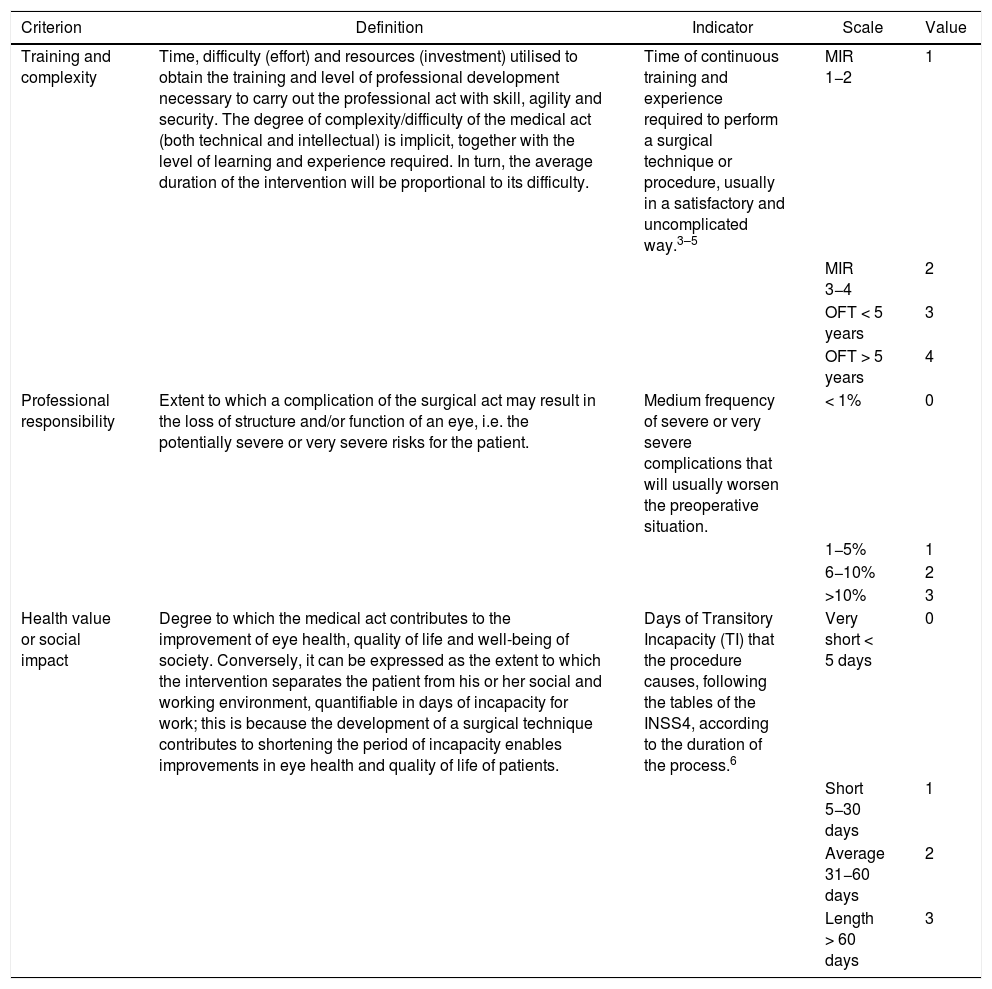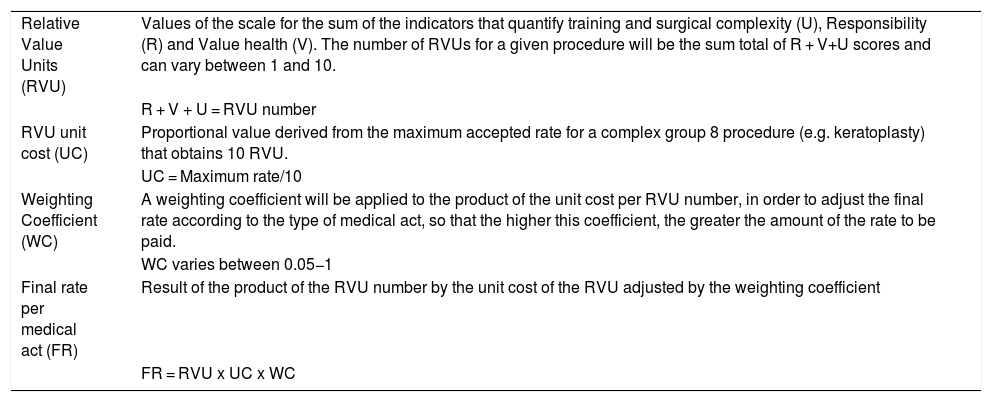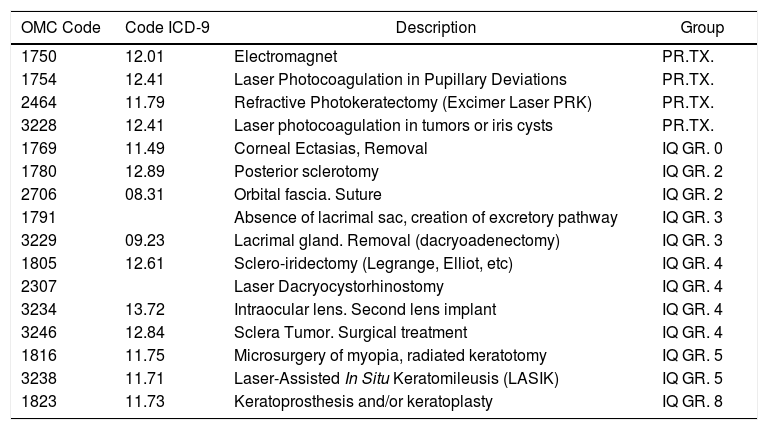To create a new list of medical procedures in ophthalmology based on the International Classification of Diseases ICD-9-CM. To establish the general principles that define criteria, quantitative indicators, and scales. To develop the algorithms needed to calculate fees for medical procedures.
MethodsThe out-of-date processes were removed from the list, and new techniques were added, descriptors were modified, procedures with similar descriptions were grouped together, and others were relocated to other group according to surgical complexity conditions. The criteria to calculate the medical fees were defined: training and complexity (U), proficient responsibility (R), and health value (V), with their respective quantitative indicators: period of training necessary to master a technique, frequency of complications that worsen the preoperative situation, and days of incapacity for work due to the process. The Relative Value Unit (RVU) was defined as the score sum of R, V and U. The final fee per medical procedure was calculated as the product of the RVU by its unit cost and by the weighting coefficient (WC).
ResultsA new catalogue was prepared with 161 medical procedures, grouped into consultations, diagnostic procedures (DX.PR), therapeutic procedures (TX.PR), and surgical interventions, increasing in complexity from group 0 to group 8. The following characters were described for each one of the procedures: OMC and ICD-9-MC code, descriptor term, group, proposed modification: no changes or minimums in the descriptors, grouping of acts by similar definitions, change of origin group, new procedures, and procedures removed. The indicators for assessment were also scored: U between 1−4 points, and R and V between 0−3 points. Using their sum, the number of RVUs per medical procedure (between 1 and 10) was calculated which, together with the unit cost of the RVU and the WC (between 0.05 and 1), will determine the final rate.
ConclusionsThe new standardised ophthalmological nomenclature updates and improves the old classification, adapting the procedures to the descriptors included in the ICD-9-CM, and incorporating all the new techniques. Additionally, the declaration of the general principles allows defining new criteria, quantitative indicators, rating scales, and algorithms to calculate fees for medical procedures.
Elaborar un nuevo nomenclátor de actos y procedimientos médicos en oftalmología basado en la Clasificación Internacional de Enfermedades CIE-9-MC. Establecer los principios generales y definir los criterios de baremación, indicadores cuantitativos y escalas de valoración. Determinar los algoritmos necesarios para el cómputo de las tarifas retributivas por acto médico.
MétodosSobre el nomenclátor vigente se eliminaron los procesos obsoletos, añadieron otros nuevos, modificaron descriptores, agruparon procedimientos con descripciones similares y trasladaron de grupo otros por razones de complejidad quirúrgica. Se definieron los criterios de baremación para el cálculo de las retribuciones médicas: formación y complejidad (U), responsabilidad profesional (R) y valor salud (V), con sus indicadores cuantitativos respectivamente: periodo de formación necesario para dominar una técnica, frecuencia de complicaciones que agravan la situación preoperatoria, y días de incapacidad laboral que ocasiona el proceso. Se definieron las Unidades Relativas de Valor (URV) como la suma de puntos de U, R y V. La tarifa final por acto médico se calculará como el producto del número de URV por su coste unitario y por el coeficiente de ponderación (CP).
ResultadosSe elaboró un nuevo nomenclátor con 161 actos médicos agrupados en consultas, procedimientos diagnósticos (PR.DX), procedimientos terapéuticos (PR.TX) e intervenciones quirúrgicas (IQ) crecientes en complejidad desde el grupo 0 hasta el grupo 8. Para cada uno de los actos se describieron los siguientes caracteres: códigos OMC y CIE-9-MC, término descriptor, grupo, modificación propuesta: sin cambios o mínimos en los descriptores, agrupación de actos por definiciones similares, cambio de grupo de origen, actos eliminados y nuevos procedimientos. Asimismo, fueron puntuados los tres criterios de baremación: U entre 1-4, R entre 0-3 y V entre 0-3. Mediante su suma se calcularon el número de URV por acto médico (entre 1 y 10), que junto con el coste unitario de la URV y el CP (entre 0,05 y 1) determinarán la tarifa final.
ConclusionesEl nuevo nomenclátor de oftalmología actualiza y mejora el catálogo antiguo, adecuando los procedimientos a los descriptores recogidos en la CIE-9-MC e incorporando todas las técnicas actuales. Adicionalmente, la declaración de los principios generales permite definir nuevos criterios de baremación, indicadores cuantitativos, escalas de valoración y algoritmos de cómputo de las tarifas por acto médico.
Artículo
Comprando el artículo el PDF del mismo podrá ser descargado
Precio 19,34 €
Comprar ahora










